Expectations for Croatia's Economy at Highest Level Since Pandemic Outbreak
ZAGREB, 25 February, 2021 - Expectations for the Croatian economy increased in February to the highest level since March 2020 reflecting the wave of optimism in the services and retail sectors, as business leaders signalled a lower demand for workers, a European Commission report showed on Thursday.
In February, the Economic Sentiment Indicator (ESI) was 94.1 points, or 3.9 points higher than in January, which was its highest level since March 2020 and the outbreak of the coronavirus pandemic. Its value, however, is below the long term average of 100 points.
The greatest improvement was observed in services confidence, increasing by 6.5 points. Retail and industry confidence improved significantly, by 4.8 and 3.3 points respectively, reaching their highest level since March 2020. A mild improvement was registered in construction confidence and in consumer confidence, up 1.7 and 1.6 points month on month.
Business leaders, however, signalled a decline in the need for workers in the coming period, with this index falling to 90.3 points or by 3.4 points m-o-m, which is its lowest level since June last year.
Slight improvement in EU and euro area
Economic sentiment in the EU and the euro area in February registered a mild growth of 1.9 points to 93.1 and 93.4 points respectively, the EC said in its report.
The highest increase in the EU and euro area was in industry confidence, of 2.4 points in the EU and 2.8 points in the euro area.
Services confidence improved by 1.1 points in the EU and by 0.6 points in the euro area.
The slightest improvement was observed in consumer confidence - 0.8 points in the EU and 0.7 points in the euro area while construction confidence remained unchanged compared to January.
Retail confidence deteriorated, with the index falling by 0.5 points in the EU and by 0.6 points in the euro area.
Business leaders expect that they might step up hiring in the coming period so the Employment Expectations Indicator (EEI) increased by 1.7 points in the EU and by 1.8 points in the euro area, the EC report showed.
Croatia Agriculture and Food Exports Jump in 2020, Imports Fall
December 19, 2020 – A surprising success story in a difficult year as Croatia agriculture and food exports jump in 2020, while imports of the same have fallen
Good news from any place is welcome in this most difficult of years. According to provisional data from the country's Central Bureau of Statistics, the total value of Croatia agriculture and food exports in the period from January to September 2020 amounted to 1.7 billion Euros, an increase of 5 percent from the same period in 2019. Within the same period, the value of agricultural and food imports into Croatia was 2.5 billion Euros, a decline of 7.3 percent from last year.
The success of Croatia agriculture and food exports in the period means that the country's trade deficit has decreased by huge 26.6 percent compared to the same period last year. With this year's findings taken into account, the trade deficit now stands at 758.8 million Euros. © Romulić & Stojčić
© Romulić & Stojčić
Croatia agriculture and food exports covered 69 percent of total imports this year, an increase of 8.11 percent. A total of 15.86 percent of all exports from the country come from the Croatia agriculture and food exports sector.
The most important item of production within the sector is corn, which accounts for 5.4 percent of all Croatia agriculture and food exports.
From January to September 2020, the most significant products in exports were: cereals (205.4 million Euros – a growth of a huge 62.6 million Euros); various food products (168.1 million Euros – including manufactured/processed foods like sauces, soups, ice cream, sugar products); fish and other seafood (a huge 147.4 million Euros – showing a growth of 14.5 million Euros); cereals, flour, starch or milk products; confectionery products, including chocolate (135.9 million Euros – a growth of 13.8 million Euros), and tobacco-related products (122.6 million Euros). TCN recently took a closer look at the successful and well-established Croatian chocolate industry
Other successes within 2020 Croatia agriculture and food exports were live animals, with an increase of 10.1 million Euros, and the residue and waste of the food industry, which is exported to go into prepared animal foods. The latter saw an increase of 8.6 million Euros.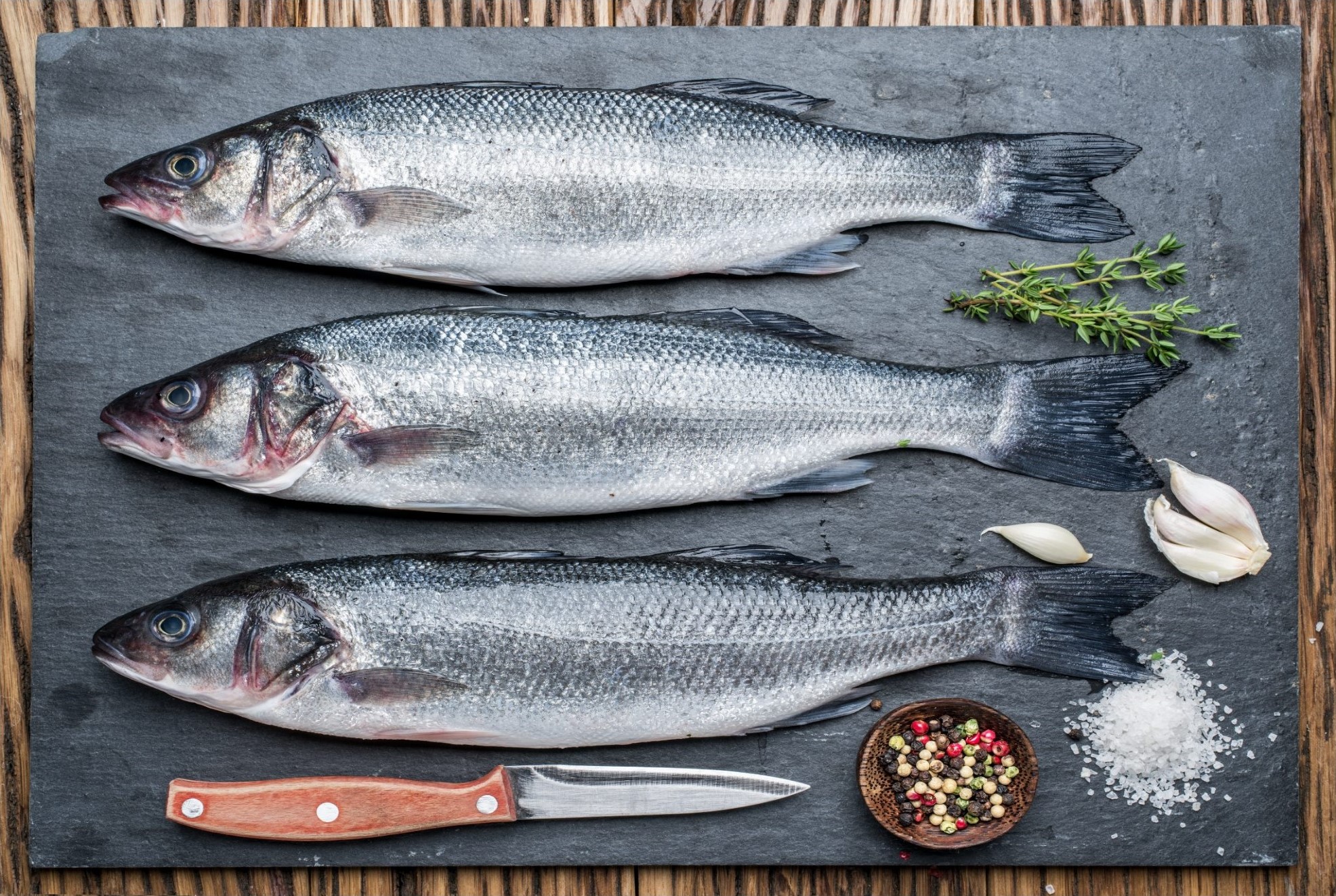
So far this year, Italy was one of the most important destinations for Croatia agriculture and food exports. Their total consumption of Croatia agriculture and food exports was 300.8 million Euros, which amounts to 17.76 percent of Croatia's exports in the sector. Croatia agriculture and food exports to Italy increased by 21.9 percent this year, while imports from Italy to Croatia in the same period was 263 million Euros, a decrease of 16.6 percent on 2019. This creates a surplus of 37.6 million Euros.
The most important Croatia agriculture and food exports to Italy are maize, wheat and soybeans, tobacco-related products, sea bass (brancin) and bream (orada).
For the last five years, Croatia agriculture and food exports top consumer has been Germany. For the past seven years, Germany has also been the country from which Croatia has imported the most.
2020 Corona Crisis as Test of Strength of Croatia's Economy and Public Finances
ZAGREB, Dec 19, 2020 - The outgoing year 2020, which was supposed to have been a year of continued economic growth, has turned into a year marked by the COVID 19 pandemic that has tested the strength of public finances.
At the very beginning, 2020 seemed to be similar to the previous five or six years: nine laws regulating tax changes ushered in the fourth round of a tax reform which shouldincrease the post-tax disposable income by HRK 2.4 billion. The ordinary pace of the social and economic activities continued against a background of more and more information about the spread of the coronavirus infection in China.
25 February - 1st registered case of coronavirus infection in Croatia
On 25 February, Croatia's health authorities reported that they had confirmed the first case of the infection with the novel virus in the country. Immediately after that, citizens rushed to stores to buy large quantities of food and hygienic products. Traffic across borders was also made more difficult due to a high number of passengers going back home and stringent controls at border crossings.
On 12 March, Prime Minister Andrej Plenkovic announced first anti-COVID restrictive measures and reassured the enterprise sector that compensatory measures for businesses were being hammered out. The PM put an emphasis on the retention of jobs.
In mid-March, the Croatian National Bank (HNB) assessed that the earlier forecasts of economic growth would have to be revised, and for the first time in its history the central bank purchased state bonds in the amount of 213 million kuna.
HNB-ECB swap line deal, 1st set of measures to offset lockdown damage to economy
In March, the HNB conducted five interventions on the foreign exchange market to maintain the stability of the exchange rate of the kuna, selling a total of € 2.25 billion. Since then, it has also taken some other measures to mitigate the economic impact of the coronavirus pandemic. The HNB also released HRK 3.8 billion to banks in a structural operation and HRK 1.85 billion in regular ones in that period.
In mid-April, the HNB said it had agreed with the European Central Bank (ECB) to set up a precautionary currency agreement, known as a swap line, that will allow the HNB to borrow up to €2 billion from the ECB in exchange for Croatian kuna. The HNB said in a press release that the precautionary currency swap line would be activated if needed.
This swap line gives the HNB "the space to provide additional euro liquidity to Croatian financial institutions, should they need it, without using its own international reserves."
The central bank said that it "will notify the ECB of the use of euro liquidity acquired through the currency swap line. The currency swap line will remain in place until 31 December 2020, and can be extended if necessary."
In the second half of March, public events and gatherings were cancelled, and the government and the parliament adopted the first HRK 30 billion-worth set of compensatory schemes, with the aim of retaining jobs and ensuring funds for wages. The government also financed a minimum net monthly wage of HRK 3,250. The first package, worth HRK 30 billion (€4bn), included 63 measures aimed at those that were already feeling or were yet to feel the consequences of the crisis.
Lockdown and earthquake
Croatia went into a lockdown on 19 March and on 22 March, Zagreb and its environs were hit by an earthquake with a magnitude of 5.5 on the Richter scale which kille a teenage girl in downtown Zagreb and caused serious material damage, estimated at HRK 42 billion, in the city and nearby counties. Currently, 12 billion kuna has been made available for the reconstruction as an initial fund coming from the EU Solidarity Fund plus a US$ 200 million loan provided by the World Bank.
The fund for the post-earthquake reconstruction of Zagreb and two neighbouring counties has been established in the meantime, with renowned manager Damir Vandjelic at its helm. He has said that the total revenues of the construction sector in Croatia in 2019 came to 18 billion kuna, whereas the activities in the reconstruction of quake-damaged buildings would bring 3-4 billion kuna annually.
2nd set of compensatory measures
In April, the government introduced the second rescue package to save jobs and help the economy, including increasing the net minimum wage to HRK 4,000 (€725). In total, the state was expected to pay HRK 5,460 per employee as a furlough measure in April, May and June. The state funded the measure with HRK 8.5 billion.
Secondly, the government partly or fully exempted some businesses from taxes for April, May, and July (12 billion kuna).
The third measure in this package applied to VAT payments, making possible for companies to defer such payments until the billing of invoices issued.
In mid-April, the Croatian parliament unanimously (with 120 votes 'for') adopted the government-sponsored law under which the enforcement of monetary assets of natural persons would be suspended for a period of three months, and if necessary for an additional three months.
Throughout May, the epidemic ebbed away, and 23 May was the first day since the outbreak of the infection without any new case of coronavirus.
The favourable circumstances enabled the gradual ease of the restrictions and reopening of non-essential shops and hospitality services.
In late June, Croatia adopted a short-time work scheme as one of the measures to help the businesses affected by the corona crisis.
Tourist season, parliamentary elections
Two summer months, July and August, were marked by the 5 July parliamentary elections, with the Croatian Democratic Union (HDZ) being a relative winner. After that, it and its junior partners formed the new government, the second cabinet led by Prime Minister Andrej Plenkovic.
During the peak summer season, more and more tourists travelled to Croatia. The data for the first nine months of 2020 show that 6.6 million visitors were in Croatia in that period, making 39.7 million overnight stays, or 63.4% fewer travellers and 54% fewer overnight stays compared to January-September 2019.
Coronavirus 'second wave'
In September, the government unveiled a new rescue package witch also included COVID loans to improve the liquidity of companies in distress due to the corona crisis.
The government adopted budget guidelines for the next three years, which project a 8% GDP drop this year, a 5% growth in 2021, a 3.4% growth in 2022 and a 3.1% growth in 2023.
This year, the budget gap is expected at 6.7% of GDP, while in 2021 it should be reduced to 2.9%, which is within the Maastricht criteria, the government said when unveiling the guidelines in late September.
With the deterioration of the epidemic in November and in the first half of December, the government continued providing assistance through a job-retention scheme and other measures.
However, the dissatisfaction of the worst affected businesses, notably enterprises in the transport and hospitality sectors, was growing. As a result, apart from the HUP, HGK and HOK business associations, one more association -- the Voice of Entrepreneurs ("Glas Poduzetnika") -- was set up, bringing together disgruntled businesses.
In mid-December, Prime Minister Andrej Plenkovic said that Croatia was now facing a challenging period in the coronavirus epidemic which has cost Croatia HRK 30 billion so far and that the human casualties and the high number of people infected call for new measures.
The Prime Minister underscored that since the outbreak of the epidemic the government has spent HRK 30 billion through various activities to maintain a normal life and to enable the health system to continue functioning.
ERM II and journey to euro area, OCED membership
2020 would be also remembered for Croatia's admission to the Exchange Rate Mechanism (ERM II) in July.
The European Central Bank (ECB) and the European Commission announced on 13 July that Croatia had been admitted to ERM II, the key step in the process of adopting the euro, and that the Croatian National Bank (HNB) had established close cooperation with the ECB. Croatia now faces the job of meeting the Maastricht criteria in the next two years.
In mid-December, Plenkovic said that the coronavirus crisis had once again shown the importance of Croatia's membership bid to join the Organisation for Economic Cooperation and Development (OECD), which continued to be one of the government's priorities. The Croatian government sent a formal membership request to the OECD in January 2017 and since then it has candidate status. The decision on accepting it as a member has to be unanimously adopted by the OECD Council after which the accession process begins.
EU's Multiannual Financial Framework, €22 bn to be made availabe to Croatia
The corona crisis has also tested the institutions of the European Union and its response to the new circumstances. The most important event in this context is the July agreement of the European Council on the new Multiannual Financial Framework (MFF), including a €750 billion recovery fund.
Of the €1.8 trillion long-term EU budget, approved in mid-December by the European Parliament, Croatia should receive a total of €22 billion from those sources.
The Next Generation EU plan was adopted in synergy with the MFF 2021-2027, and it should repair the economic and social damage caused by the coronavirus pandemic, kick-start European recovery and protect and create jobs. Slightly over €12.6 billion from the new MFF and €10.6 billion from the Next Generation EU instrument will be available to Croatia.
Credit rating agencies' assessment
In mid-November, the Moody's credit rating agency upgraded Croatia's rating to Ba1 from Ba2 and changed the outlook to stable from positive, citing enhanced institutional capacity and policymaking as the country enters a critical phase of euro area accession and reduced exposure to foreign-currency debt risk.
Two other major credit rating agencies, Standard & Poor's and Fitch, keep Croatia's credit rating at investment grade. S&P affirmed its rating of 'BBB-/A-3' with a stable outlook in September.
On 5 December, Fitch Ratings affirmed Croatia's long-term foreign-currency issuer default rating (IDR) at BBB-, assessing the outlook as stable and noting that it expects gradual recovery from the coronavirus crisis with the help of EU funds as well as that limited capacity to absorb EU money poses a problem.
(€1 = HRK 7.5)
Faculty of Economics University of Zagreb Celebrates 100 Years
ZAGREB December 5, 2020 – With over 9000 students currently enrolled, the Faculty of Economics University of Zagreb is the largest faculty in Croatia. In 2020, this internationally renowned institution celebrates its 100th birthday, so TCN decided to take a closer look.
Every other student you meet in Croatia seems to study economy. It makes you wonder where they all go to after their studies are complete. Are there really so many positions for economists in Croatia?
In 2020, the Faculty of Economics University of Zagreb celebrates its 100th birthday. The long list of its famous former students gives a clue to where all the Croatian economists go – the tourism sector, diplomacy and international relations, business, politics and government.
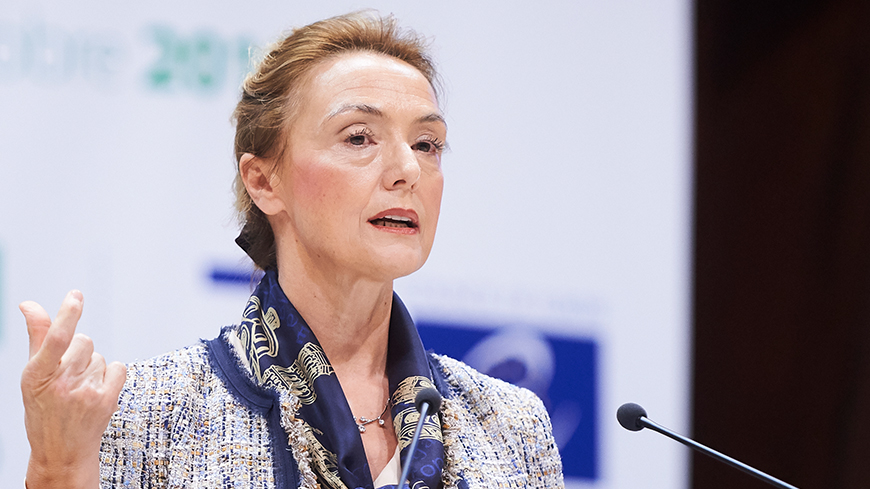 Marija Pejčinović Burić, a graduate of the Faculty of Economics of the University of Zagreb and the current Secretary General of the Council of Europe. After graduating, like Savka Dabčević-Kučar, she became o doctor of economics and before taking her current position served as Croatia's Deputy Prime Minister and Minister of Foreign and European Affairs © Council of Europe
Marija Pejčinović Burić, a graduate of the Faculty of Economics of the University of Zagreb and the current Secretary General of the Council of Europe. After graduating, like Savka Dabčević-Kučar, she became o doctor of economics and before taking her current position served as Croatia's Deputy Prime Minister and Minister of Foreign and European Affairs © Council of Europe
Graduates of the Faculty of Economics University of Zagreb have served as mayors of Zagreb and Split, Deputy Prime Minister of Croatia, Minister of Finance, Minister of the Economy, Secretary-General of the Council of Europe, Governers of the Croatian National Bank, Vice-President of the UN World Food Council, President of the Croatian Football Association, Minister of Environmental and Nature Protection, special advisors to the President of Croatia and countless university professors, including several former rectors of the University of Zagreb. Within its graduate professors, it has produced no less than 19 full members of the prestigious Croatian Academy of Sciences and Arts, more than any other single institution in the country.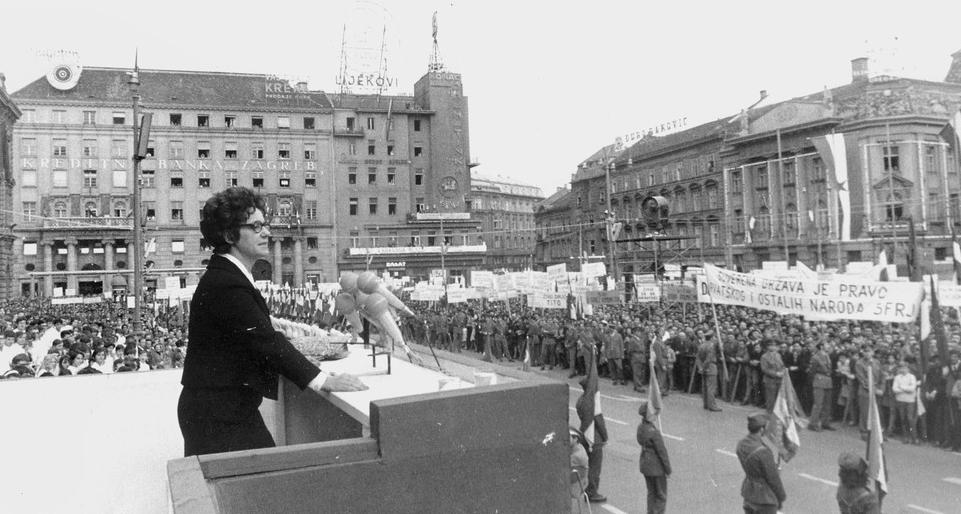 Savka Dabčević-Kučar, a graduate of the Faculty of Economics of the University of Zagreb. Born on Korčula, she became an anti-fascist in World War II, joining the partisans after her brother was beaten by fascists. After graduating, she continued to study at the faculty and became one of the first doctors of economics in Croatia, raising eyebrows by choosing to write her doctorate dissertation about a non-Marxist economic theorist (Englishman John Maynard Keynes). She became a professor at the faculty in the 1950s and despite her great advances in political life, remained a committed teacher at the faculty until 1971. In 1967, she was elected President of the Socialist Republic of Croatia. In 1969, she moved to an even more important position - that of president of the Central Committee of the League of Communists of Croatia. She was the first woman in Europe to be appointed head of government of a political entity and the first female in Croatia to hold an office equivalent to a head of government. In this picture, she addressed supporters on Ban Jelacic Square Zagreb during the movement called the Croatian Spring, which called for greater autonomy for Croatia. At the address, thousands cheered her as “Savka, queen of the Croats”. For her pivotal role in the movement, she was removed from her positions and public life and retired. She returned to politics in 1990 upon the collapse of communism in Europe and during the Croatian war of independence was one of the few politicians who visited the front lines of battle in Slavonia, Petrinja, Pokupski and the Dalmatian hinterland
Savka Dabčević-Kučar, a graduate of the Faculty of Economics of the University of Zagreb. Born on Korčula, she became an anti-fascist in World War II, joining the partisans after her brother was beaten by fascists. After graduating, she continued to study at the faculty and became one of the first doctors of economics in Croatia, raising eyebrows by choosing to write her doctorate dissertation about a non-Marxist economic theorist (Englishman John Maynard Keynes). She became a professor at the faculty in the 1950s and despite her great advances in political life, remained a committed teacher at the faculty until 1971. In 1967, she was elected President of the Socialist Republic of Croatia. In 1969, she moved to an even more important position - that of president of the Central Committee of the League of Communists of Croatia. She was the first woman in Europe to be appointed head of government of a political entity and the first female in Croatia to hold an office equivalent to a head of government. In this picture, she addressed supporters on Ban Jelacic Square Zagreb during the movement called the Croatian Spring, which called for greater autonomy for Croatia. At the address, thousands cheered her as “Savka, queen of the Croats”. For her pivotal role in the movement, she was removed from her positions and public life and retired. She returned to politics in 1990 upon the collapse of communism in Europe and during the Croatian war of independence was one of the few politicians who visited the front lines of battle in Slavonia, Petrinja, Pokupski and the Dalmatian hinterland
The Faculty of Economics University of Zagreb is the largest faculty in the country. Over its 100 year history, it has established itself as an internationally respected institution. Today, it has around 9000 persons enrolled, caters for international students with some courses in English and has produced over 86, 000 graduates, including 856 doctors of science.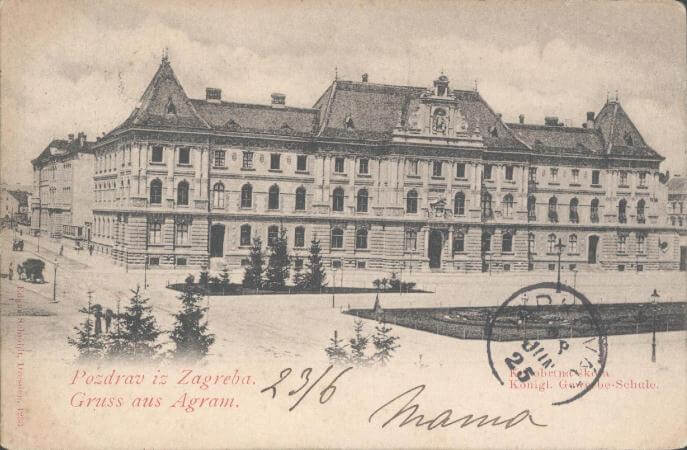 In its infancy, students of the College of Trade and Transport were taught at the Technical College, which is today the Museum of Arts and Crafts in Zagreb © National and University Library in Zagreb
In its infancy, students of the College of Trade and Transport were taught at the Technical College, which is today the Museum of Arts and Crafts in Zagreb © National and University Library in Zagreb
The history of the Faculty of Economics University of Zagreb starts with the opening in 1920 of its forerunner, the Zagreb College of Trade and Transport. Its purpose was to educate in the areas of banking, domestic and international trade, transport, consular services, insurance and the education of teachers. Its courses lasted three years and it proved so popular that in the academic year 1923/24, some 1,125 students were enrolled.
The institution held college status until 1925 when Stjepan Radić became the Minister of Education. It must have been unusual for Radić to find himself as part of the government of the Kingdom of Serbs, Croats and Slovenes, the state which preceded the Kingdom of Yugoslavia. Today, Radić is best remembered as a politician outspoken in his advocacy of autonomy for Croatia. Before his appointment to the government, he had always done so in opposition. Indeed, he had been imprisoned several times for his views, which were proclaimed loudly in his writings or in person (he was a gifted public speaker). As recently as March 1925 he had been in prison but, when the political party of which he was a member officially recognised the monarchy and the state constitution, he was freed. In a remarkable turnaround, before the year's end, he was a minister in the government.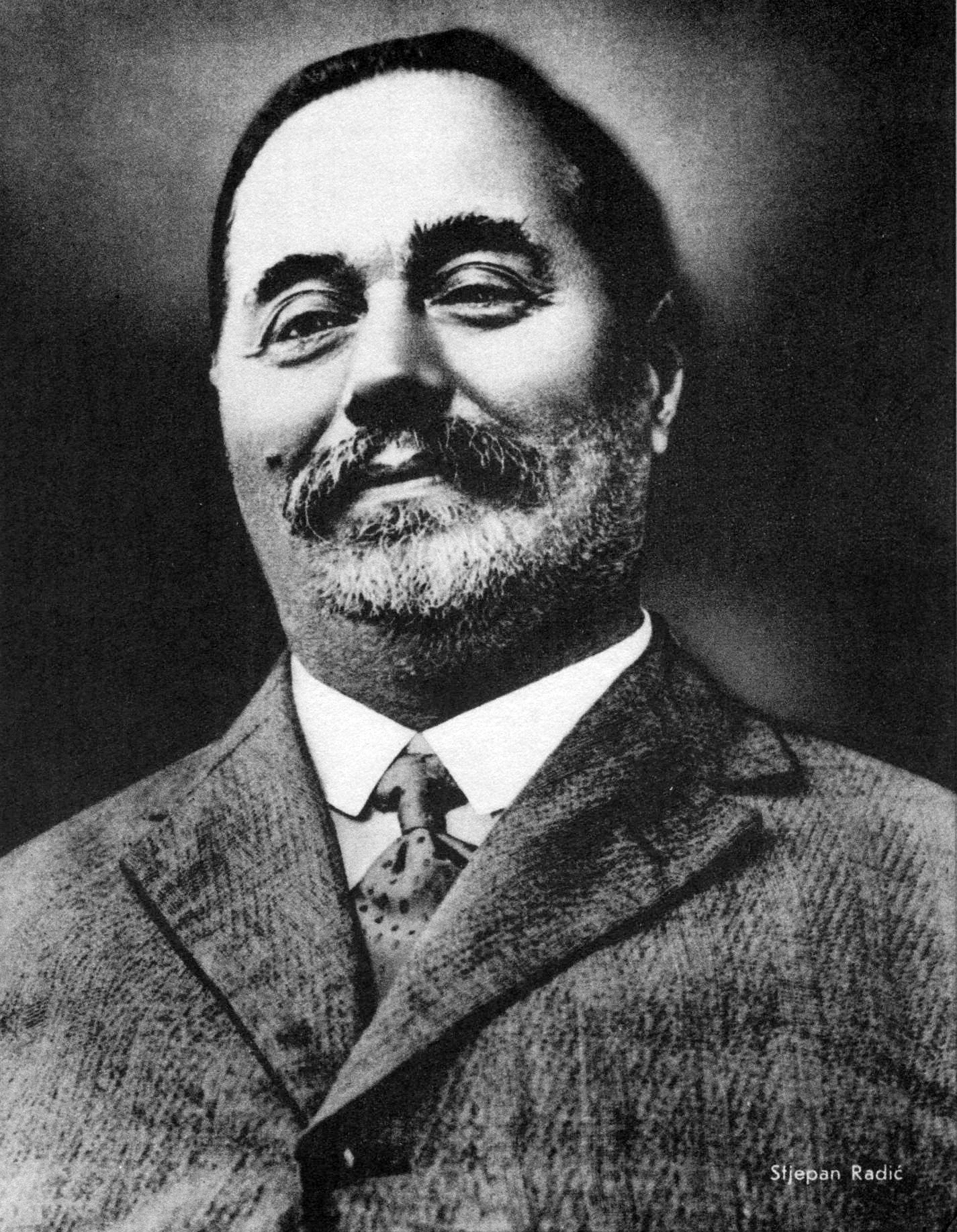 Stjepan Radić, pictured in the 1920s © public domain. In 1895 Radić was sent to prison for the public burning of the Hungarian flag in Zagreb – alongside Antun Dabčević, the father of Savka Dabčević-Kučar.
Stjepan Radić, pictured in the 1920s © public domain. In 1895 Radić was sent to prison for the public burning of the Hungarian flag in Zagreb – alongside Antun Dabčević, the father of Savka Dabčević-Kučar.
Stjepan Radić's desire for Croatian autonomy was not born from the ideals of the political class of Zagreb. The ninth of eleven children, born to a peasant family in a small village on the banks of the Sava river, just north of Sisak, Radić was very much a representative of the people whence he came. To him (and others in his family – his brother and nephew also being prominent politicians), education had the most important role to play in emancipation. He had lived in poverty in order to complete his own - after being banned from university-level educational institutions throughout the whole of the Austro-Hungarian empire for his protests against the state, he travelled penniless to Russia, France and Switzerland to complete his studies. In the latter, finance was one of his chosen subjects.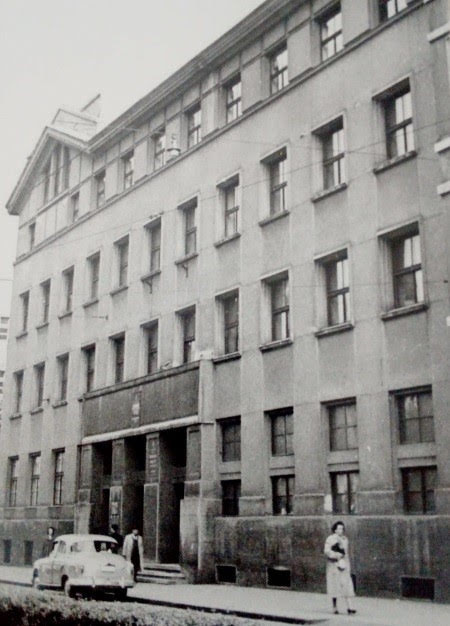 The first dedicated building of the Higher School of Economics and Commerce was located on the corner of Bauerova and Zvonirmirova © Faculty of Economics University of Zagreb
The first dedicated building of the Higher School of Economics and Commerce was located on the corner of Bauerova and Zvonirmirova © Faculty of Economics University of Zagreb
Under Radić's spell in office, the Zagreb College of Trade and Transport became the Higher School of Economics and Commerce. Its courses extended to four years, it attained university status. With no building designated to the increasingly popular institution, students had sometimes been taught at the Technical College (today's Museum of Arts and Crafts) and in parts of what is now the Mimara Museum. A dedicated home for the faculty was authorised and its construction started in 1927. Classes began at the faculty, located on the corner of Bauerova and Zvonimirova, in 1928, but within the decade the institution had outgrown its home and a plot of land in Svetice was acquired in order to build a new, larger facility. Its construction was interrupted by the Second World War and students would end up being taught on the Bauerova and Zvonimirova site all the way up to 1952.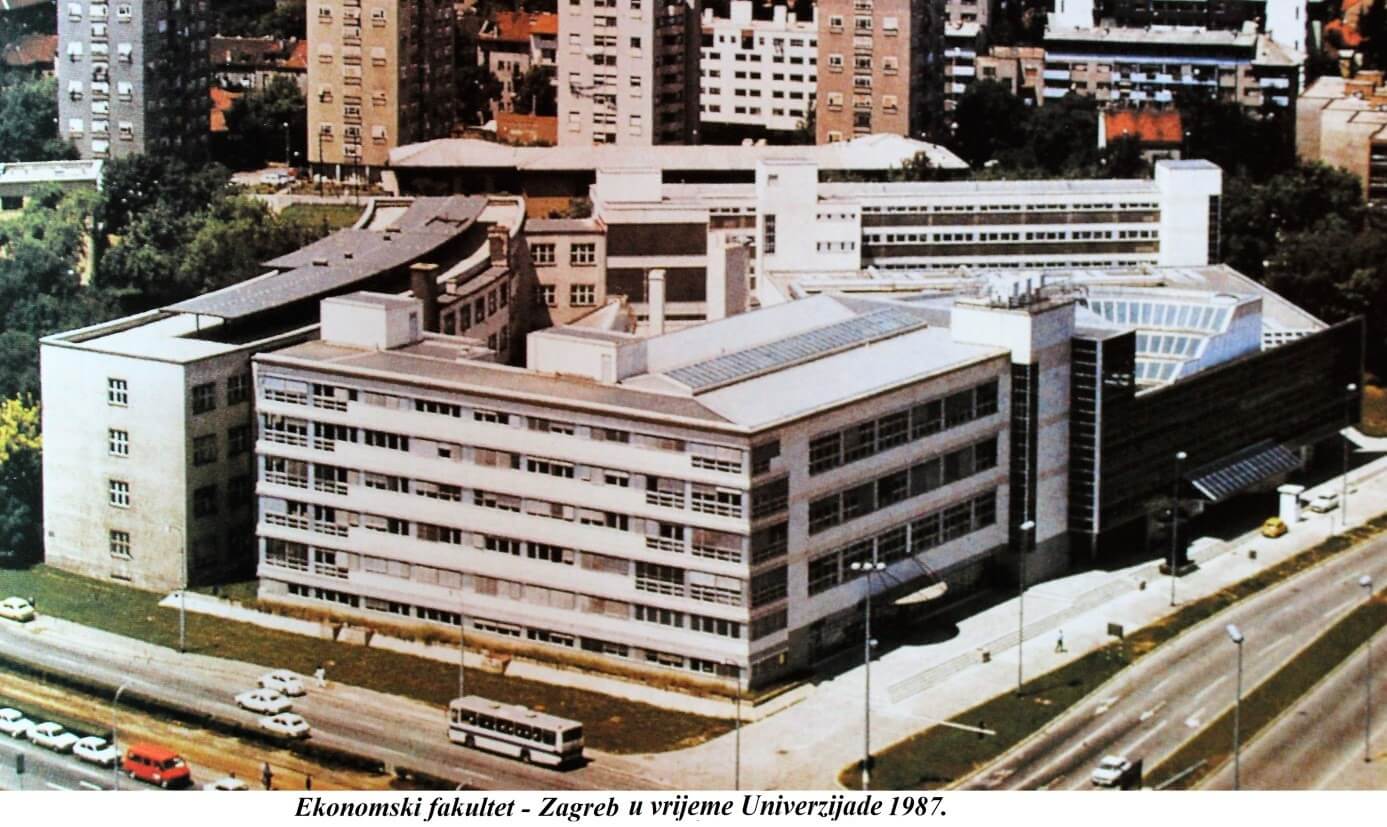 The faculty's modern building, pictured in 1987. Today, the faculty has 17 departments - Finance, Demography, Economic Theory, Business Economics, Informatics, Macroeconomics and Economic Development, Marketing, Mathematics, International Economics, Business in Foreign Languages, Organization and Management, Law, Accounting, Statistics, Trade and International Business, Tourism, Physical Education and Health © Faculty of Economics University of Zagreb
The faculty's modern building, pictured in 1987. Today, the faculty has 17 departments - Finance, Demography, Economic Theory, Business Economics, Informatics, Macroeconomics and Economic Development, Marketing, Mathematics, International Economics, Business in Foreign Languages, Organization and Management, Law, Accounting, Statistics, Trade and International Business, Tourism, Physical Education and Health © Faculty of Economics University of Zagreb
In 1947, the Higher School of Economics and Commerce became the Faculty of Economics University of Zagreb. In 1952, the faculty officially moved to the new site in Svetice. In 1968 it expanded once more when it merged with the 12-year-old College of Economics. Since then, the building at Svetice has received major upgrades and further facilities of the faculty can now also be found at the university campus in Borongaj, in Varaždin, in Koprivnica and in Bjelovar. After a century of existence, the Faculty of Economics University of Zagreb's longstanding difficulties to meet the popularity of its courses with the space available are now over. Not only can they accommodate every Croatian economy student who makes the grade, but they are also able to offer places to some of the best international students. It would surely come as no surprise if they are still educating the future elites of business, banking, finance and politics in another 100 years.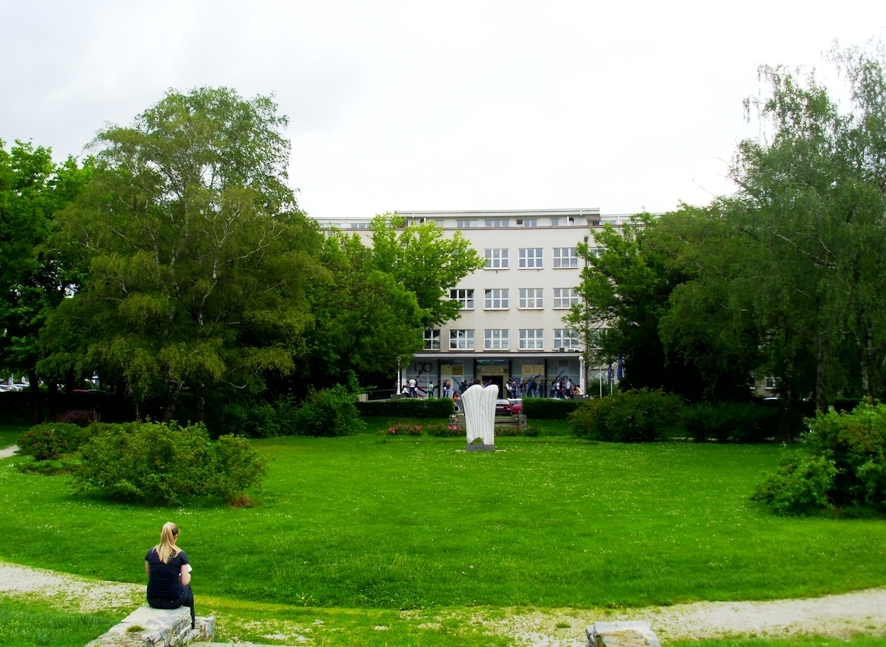
The Faculty of Economics University of Zagreb site in Svetice, as seen from its garden © Wolf - Pidgeon
Global Terrorism Index 2020: Croatia is a Completely Safe Country
ZAGREB December 2, 2020 – Croatia is a completely safe country, according to the latest figures from the Global Terrorism Index
According to the Global Terrorism Index, Croatia is a completely safe country. Their findings are reported annually by the Institute for Economy and Peace. In their most recent report (published late November 2020), from the year beginning 2018 and ending in 2019, Croatia scored an index rating of 0.0 on the impact of terrorism. This means that, in regards to the threat of and the fallout from terrorism, Croatia is a completely safe country.
In the report, terrorism affects most the citizens of three countries: Afghanistan, Iraq and Nigeria. Terrorist groups are powerful and active in these three nations. On a daily basis, they affect and change the lives of all the people who live in these countries, particularly those who inhabit larger population centres.
The situation is particularly tragic in Afghanistan (with an index rating of 9.5). 41% of all fatal victims of terrorist globally live in that one country alone. The second country most-affected on the list is Nigeria with 9%. Afghanistan and Nigeria were the only two countries which each suffered more than 1,000 deaths from terrorism.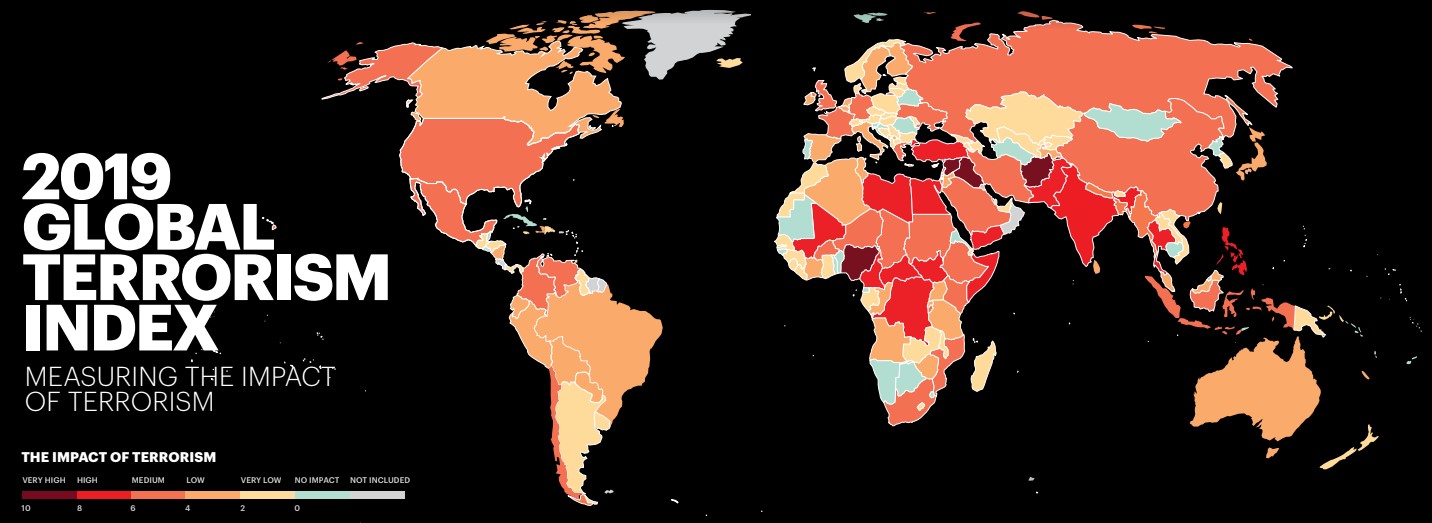 A map showing the impact of terrorism globally. The figures were compiled in a one year period between 2018 and 2019, published as an annual report in late November 2020 © Institute for Economy and Peace (IEP)
A map showing the impact of terrorism globally. The figures were compiled in a one year period between 2018 and 2019, published as an annual report in late November 2020 © Institute for Economy and Peace (IEP)
Globally deaths from terrorism fell for the fifth consecutive year in 2019 to 13,826, a 15 per cent decrease from the prior year. The peak of deaths from terrorism occurred in 2014 and this coincides with the high point of influence of the Islamic State of Iraq and the Levant (ISIS or ISIL). The figures from 2019 show a decrease of 59% since then.
A total of 63 countries recorded at least one death from terrorism in the most recent report. Although dismal reading, this is in fact the lowest number of countries to have reported such since 2013.
The global economic impact of terrorism was US$16.4 billion in the twelve-month period covered by the report, a decrease of 25 per cent from the previous year. However, the true economic impact of terrorism is much higher as these figures do not account for the indirect impact on business, investment, and the costs associated with security agencies in countering terrorism.
ISIS (or ISIL)'s centre of activity has been shown to have moved to sub-Saharan Africa in the period. Total deaths by ISIL in the region have increased by 67%. ISIL and their affiliates were also responsible for attacks in 27 countries in the year period ending 2019.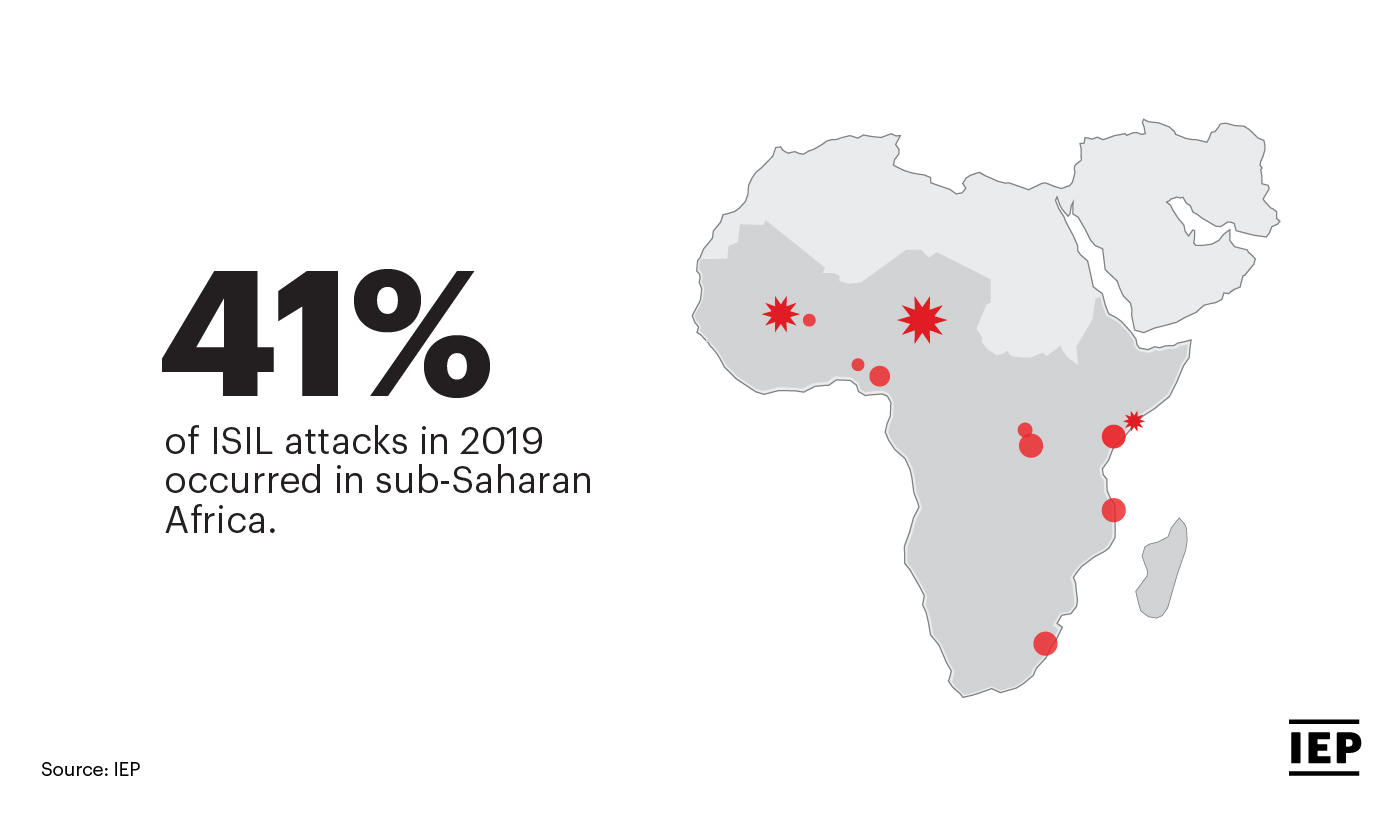 © Institute for Economy and Peace (IEP)
© Institute for Economy and Peace (IEP)
The GTI uses a number of factors to calculate its score, including the number of incidences, fatalities, injuries and property damage. The Taliban remained the world's deadliest terrorist group in 2019; however, terrorist deaths attributed to the group declined by 18%. ISIL's strength and influence also continued to decline. For the first time since the group became active, it was responsible for less than a thousand deaths throughout the year.
It is not yet known whether the attack on government buildings in Zagreb in 2020 will affect Croatia's rating on the index published next year. Although a lone endeavour, Croatian Prime Minister Andrej Plenković is the most high-profile commentator (of many) to have said the attack had elements of terrorism. The global increase in threat from domestic attacks is clearly evident within the rest of the most recent report.
In North America, Western Europe and Oceania, terrorist attacks by groups or individuals involved in far-right politics have increased by 250 per cent since 2014. They are now higher than at any time in the last 50 years. There were 89 deaths attributed to far-right terrorists in 2019. In the USA, white supremacists and other rightwing extremists have been responsible for 67% of domestic terror attacks and plots so far this year.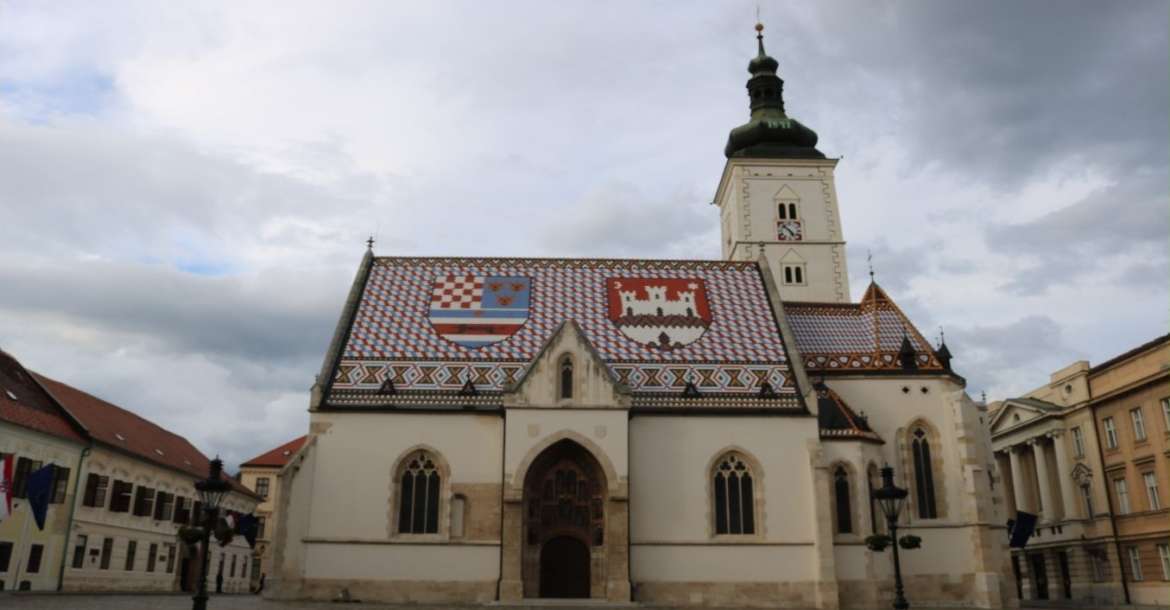 Saint Mark's Square in Zagreb, scene of a shooting in 2020, perpetrated by a Croatian citizen © Marc Rowlands
Saint Mark's Square in Zagreb, scene of a shooting in 2020, perpetrated by a Croatian citizen © Marc Rowlands
There have so far not been any terrorist actions attributable to fundamentalist Islamic groups in Croatia, unlike other European countries such as Spain, Germany, France and the UK. Eastern and southern Europe have experienced more civil unrest in direct correlation with the rise of far-right politics in the region. The popularity of far-right politics has risen ever since the 2008 financial crisis and has continued through the economic recession which followed.
Such trends are expected to continue because of the anticipated and extended economic downturn caused by COVID-19, which is likely to increase political instability and violence. Since COVID-19 was declared a global pandemic by the World Health Organization (WHO) in March 2020, preliminary data suggests a decline in both incidents and deaths from terrorism in most regions in the world. However, it is expected that the pandemic is likely to present new and distinct counter-terrorism challenges.
Of Croatia's neighbours, Bosnia and Herzegovina recorded the largest improvement in the whole of Europe with their 2019 index rating (followed by Austria and Sweden). Only two terrorist attacks were recorded in the country in 2019, compared to six the previous year. Slovenia also scored a 0.0 rating, meaning it can say that it, like Croatia is a completely safe country.
Analysts Say Croatia's GDP Dropped by About 10% in Q3 2020
ZAGREB, November 22, 2020 - Despite the fact that Croatia's economy somewhat recovered from the record decline in the second quarter, thanks to activities after the lockdown, analysts estimate that in the third quarter it also fell at a double digit rate compared to the previous year.
The national statistical office (DZS) will release at the end of next week the first estimate of gross domestic product (GDP) for Q3, and seven analysts who took part in Hina's survey expect a drop in GDP of 10.4% on the year.
Their estimates of the decline range from 9.5% to 11%.
Economy in recession
That will be the second quarter in a row that the economy declines on the year, which means it has entered a recession, but the decline will be milder compared to the record 15.1% drop in the previous quarter.
The record decline in Q2 was a consequence of the coronavirus pandemic and restrictive measures aimed at curbing the spread of the virus, which paralysed economic activity from the second half of March to the end of April.
"When the measures were relaxed in June, and especially during the summer months, most activities already started to recover. First high-frequency indicators confirm that Q3 will see a growth compared with the period from March to June, but a relatively steep decline in GDP on the year is inevitable," one of the analysts said.
Personal consumption continues to decline
The decline is mainly due to weak personal consumption, which is the largest component of GDP. Data from the national statistical office show that retail trade turnover fell by 7.6% in Q3 compared to the same period last year.
"That is mainly a consequence of trends in hospitality services, which didn't manage to compensate for losses caused by the closure of the economy even during the summer months, and tourist spending was markedly lower compared to the previous year," it was said in the survey.
Even though the summer tourist season was slightly better than expected at the start of the coronavirus crisis, the decline in tourist turnover was sharp.
According to the DZS's data, there were 6.6 million tourists in commercial accommodation establishments in the first nine months of 2020, which is a drop of about 63% from the same period last year, while the number of tourist nights dropped by 54% to 39.7 million.
The decline in industrial production also had a negative effect on GDP. In the past quarter, production dropped by 1.3% on the year.
That is a consequence of weak domestic demand, as well as foreign demand, as indicated by the decline in exports since the start of the year.
According to the DZS's data, the value of exports of goods in the first nine months of 2020 totalled about HRK 80 billion, which 4.8% less compared to the same period last year, while imports dropped by 10.1%, to approximately HRK 126 billion.
"High levels of uncertainty and worsening expectations also curbed stronger investment, while government spending is the only GDP component that is mitigating the negative trends on the demand side with its growth," one of the analysts said in Hina's survey.
Second wave of corona crisis
Because of the second wave of coronavirus spreading in Croatia and Europe, analysts also expect an economic decline in Q4 compared to the previous year.
It is expected that holiday spending and tourist activity will weaken due to epidemiological measures.
In addition, a further decline in exports and imports is expected, given the new restrictive measures introduced in most European countries due to the second wave of coronavirus, as is recession in Croatia's largest trading partners, Italy and Germany.
Deep, but brief recession?
Because of all this, a record decline in economy is expected in the entire 2020.
According to Hina's survey, seven analysts on average estimate that in the entire 2020 the economy could decline by 9.2%. Their estimates of the decline range from 8% to 10%.
The estimates of the decline have slightly decreased since three months ago analysts on average expected a drop of 10.5%.
According to one analyst, some of the reasons for that include a somewhat salvaged main tourist season, the resilience of construction (more) and industry (less) to negative trends, reduced gap in trade in goods (goods exports more resilient than imports) and, finally, the government's fiscal impulse through wage subsidies and maintaining household income levels, as well as the moratorium on loan repayment.
Despite being mitigated, this year's economic downturn could be greater than during the 2009 financial crisis, when the GDP dropped by a record 7.4%.
The government itself expects a greater drop in economy than in 2009, so it estimates that the GDP will decline by 8%.
The Croatian National Bank also expects a drop of about 8%, while the European Commission estimates that Croatia's economy will decline by 9.6% this year.
While the drop in GDP in 2020 will likely be deeper than during the global financial crisis, it is expected that this recession will be shorter. Then, the recession lasted for six years, while this time the economy is expected to grow as soon as next year.
Best Economic Examples in Croatia in 2020 Are Being Selected
November 4, 2020 – The best economic examples in Croatia will be awarded in early December, which will be decided by an expert jury, but also by the general public.
As Večernji list/Stela Lechpammer reports, one of the main reasons why Večernji list and Poslovni Dnevnik launched the selection of Businessman of the Year and Economic Event of the Year four years ago is to divert attention from negativity and trivia to positive and successful stories from the economy.
Due to the coronavirus pandemic, this is even more important now, and this autumn the manifestation continues. The expert jury and readers will select new, and perhaps some already known companies, names, and events that marked the Croatian economy this year.
Despite the often negative and uninspiring political and social environment, Večernji list and Poslovni Dnevnik have recognized Croatian businessmen as promoters of excellence, innovation, and successful business ventures. By highlighting positive examples such as business excellence, export success, the opening of new plants, and thus jobs, they want to open a new perspective on life in Croatia.
"Economic successes are an incentive for many small and medium-sized enterprises and a message to young people not to leave Croatia, which has been a particularly painful topic for several years now," said the organizers.
The winners will be decided by the general public and an expert jury composed of leading Croatian journalists and editors who cover the economy, as well as the professionals and scientists. The winners will be awarded in early December in four categories.
"The selection of businessmen and the economic event of the year is of great importance, and at the same time, it is very important that the selection is carried out according to objective criteria and that the recognition goes into the right hands. We need to look at the placement and quality of products, indebtedness," says a well-known Croatian entrepreneur and one of the richest Croats, Branko Roglić.
Based on objective criteria, the expert jury will select the businessman of the year, and the criteria are business excellence, above-average business results, a successful investment project, job creation, and export success. On the other hand, readers will make decisions based on the reputation that each company and entrepreneur have in public.
"The popularization of entrepreneurship in Croatia is very important and that is why this is an important event. Most entrepreneurs in Croatia are very hard-working people who run the economy and take care of their employees, but often the public has a wrong image, both because of the past and because there are always exceptions in every business that ruins the reputation. I would like, when someone in Croatia mentions an entrepreneur, to think of a team from Infinum, Nanobit, Infobip," said the two-time winner of this competition Mate Rimac.
Among the winners in recent years were Ante Vlahović from the Adris group, Željko Kukurin from the tourist company Valamar, and Marin Pucar, the leader of Podravka.
To read more about business in Croatia, follow TCN's dedicated page.
PHOTOS: Pula Amphitheatre and Zagreb Arena Lit Red for Events Industry
September 3, 2020 - Three of Croatia's most internationally famous venues in the events industry were lit in spectacular red on Monday. Pula amphitheatre, Zagreb Arena and Fort Punta Christo were bathed in light from sunset until after dark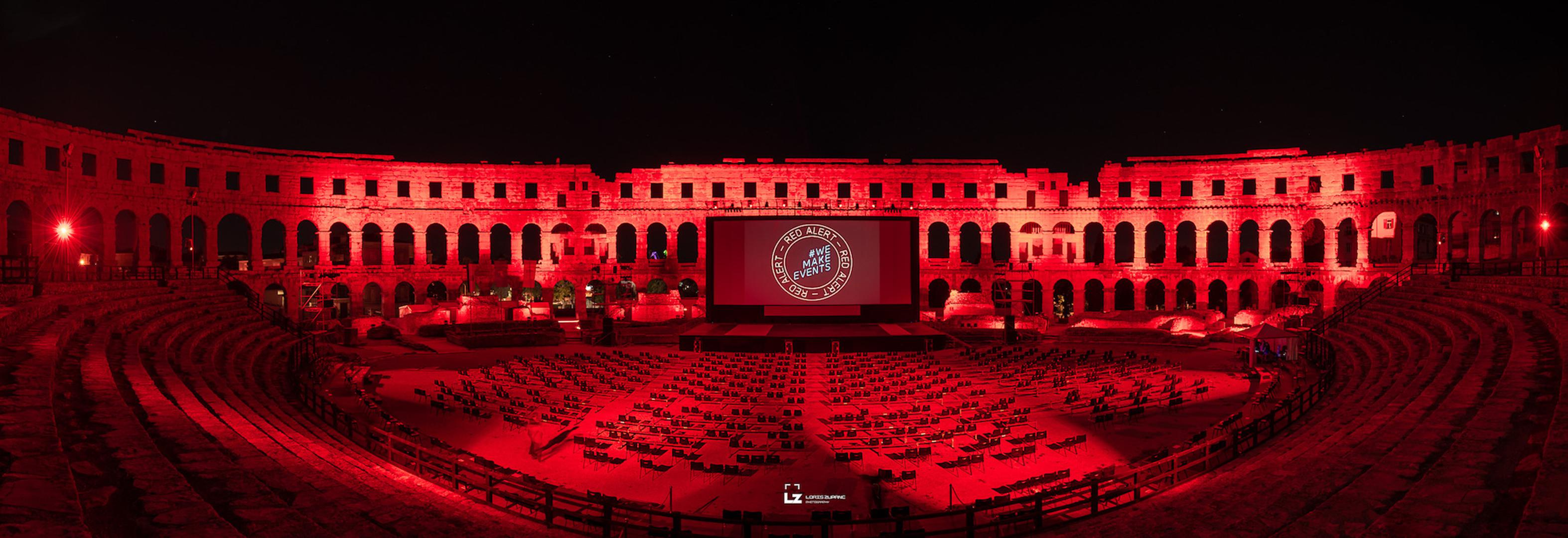
Three of Croatia's most internationally famous venues used by the events industry were lit in spectacular red on Monday. Pula amphitheatre, Zagreb Arena and Fort Punta Christo, also in Pula were bathed in light from sunset until after dark.
Though the change in appearance was enjoyable and visually impressive, the action was undertaken to send a strong message. It was part of a worldwide campaign to highlight the effects of Coronavirus on the events industry and those who work within it.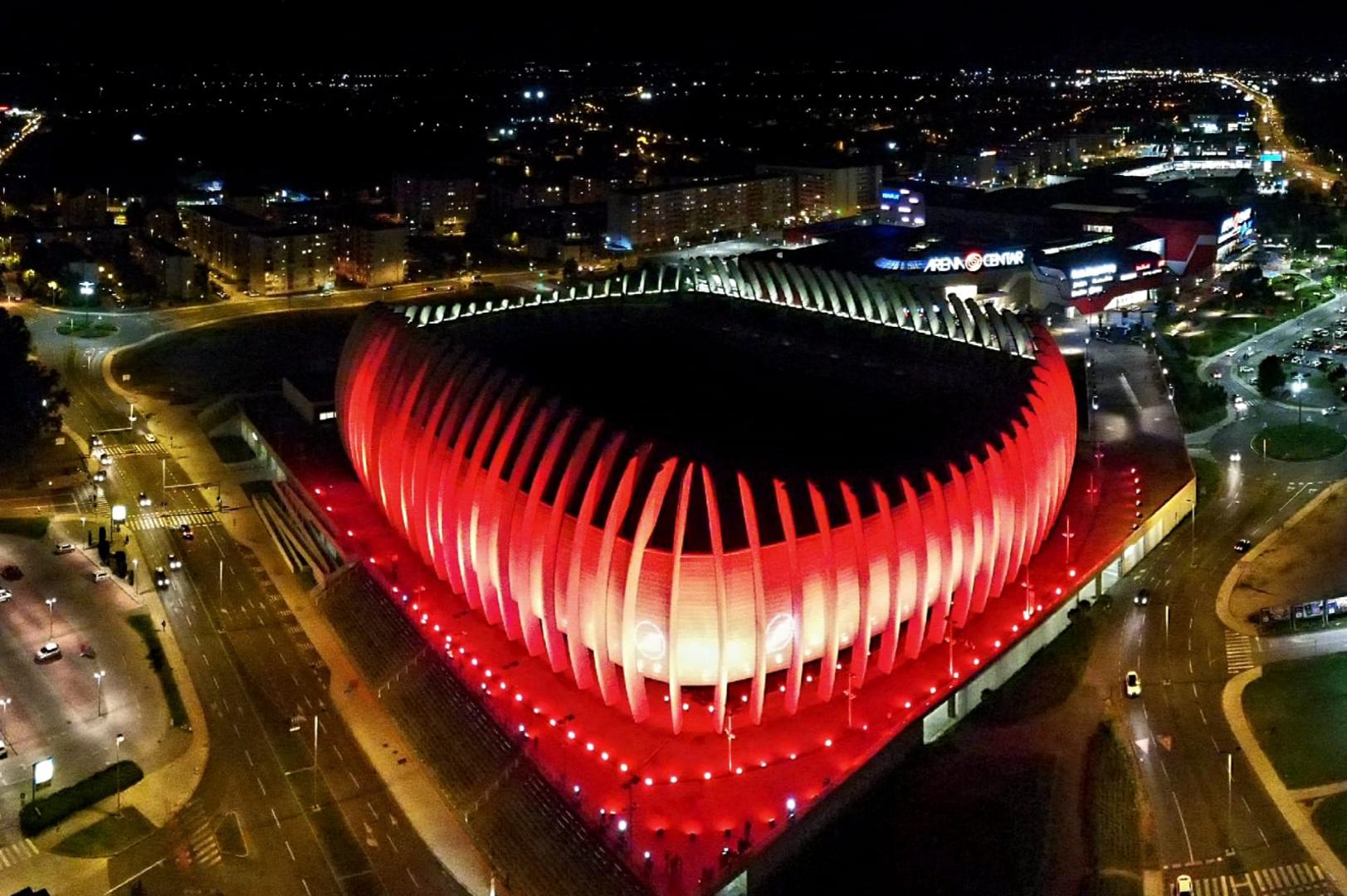
Some of the most famous historical buildings, concert venues and event halls in the world joined the Red Alert campaign and were similarly lit on the same night.
Large public events have been put on hold over most of the world under epidemiological guidelines. Seating arrangements in theatres, conference halls, sports and music halls are simply not compatible with social distancing regulations – many such venues could not make a profit by holding events at 50% capacity.
This has affected millions around the world who work in the events industry, from musicians and performers to technicians, bookers, agents, the media, PR representatives, venue management and general staff. Freelancers operating within the events industry are some of the hardest hit and have had all of their income sources removed completely. Many who operate in the events industry are highly trained and skilled, so diversifying into other industries can be problematic.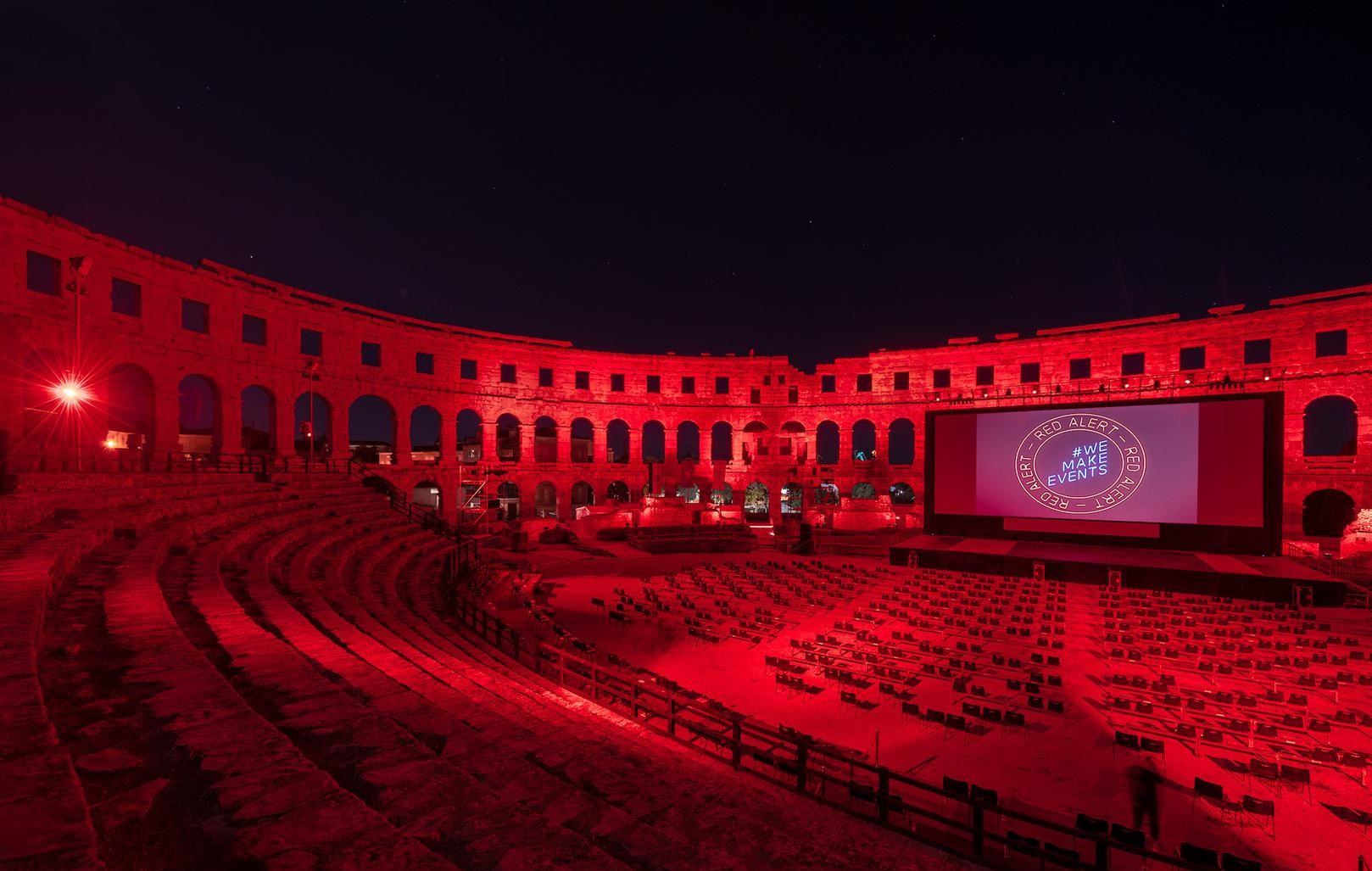
Pula amphitheatre (also known as Pula Arena) is a massively popular open-air venue in warmer months. It holds spectacular opera, ballet and classical music events as well as hosting a film festival. Like Zagreb Arena, it attracts some of the biggest names in pop and rock music. Fort Punta Christo has become famous all over Europe and further over the last decade, thanks to the internationally renowned Outlook and Dimensions festivals. Those events were supposed to take place in Tisno, at The Garden festival site. But, along with seven further festivals due to be held there this year, they chose to cancel in order to safeguard the health of their attendees and locals.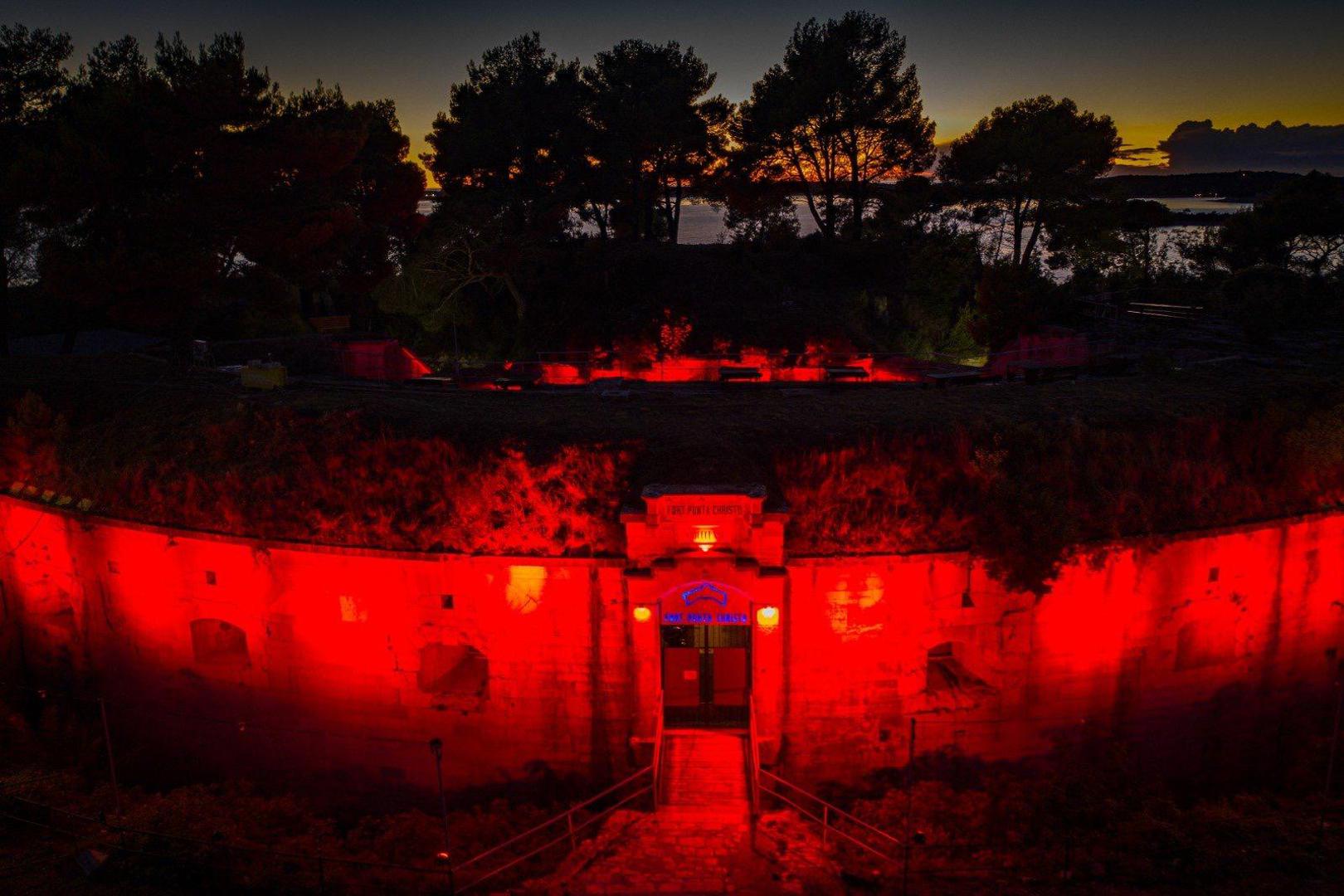
Fort Punta Christo in Pula is widely known as a host site for international music festivals
The Croatian events industry alone is comprised of 2000 business entities, has more than 12,000 employees, and annually generates HRK 4.5 billion. Autumn/winter 2021 is the soonest estimated point at which large scale events could return to normal. The Red Alert campaign has been undertaken to highlight the plight of the events industry as many sections within it face total collapse if deprived of work until then. 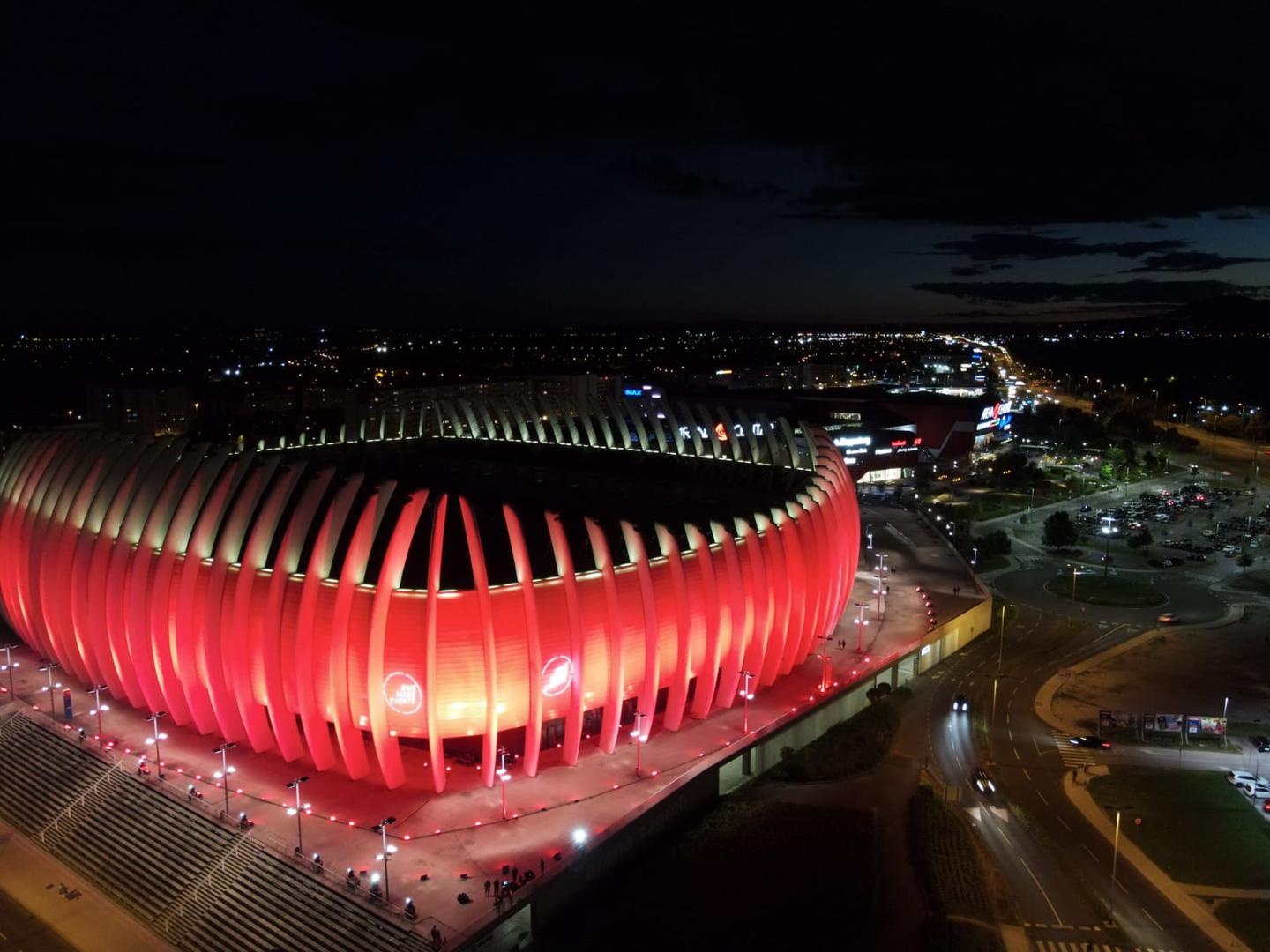
All photos © Red Alert
For the latest travel info, bookmark our main travel info article, which is updated daily.
Read the Croatian Travel Update in your language - now available in 24 languages
Economic Expectations for Croatia Significantly Improve in August
ZAGREB, August 28, 2020 - Economic expectations in Croatia improved significantly in August, primarily due to the hospitality sector and in line with trends in the European Union and the euro zone, a report released by the European Commission on Friday notes.
The Economic Sentiment Indicator (ESI) for Croatia increased by 7.7 points in August compared to July, reaching 90.9 points, after slipping by 1.6 points in July, the commission's regular business and consumer survey for August shows.
That is a significant improvement compared to the record low 72.3 points in April when lockdown measures were in full swing due to the coronavirus epidemic.
The best improvement in confidence in August by far was in the services sector which is evident in the jump of 19.3 points in the services confidence index.
Industry confidence and retail confidence too increased by 5.3 and 4.3 points respectively.
A mild improvement was recorded in the consumer confidence index, which increased by 2.2 points.
Construction confidence was an exception, with confidence falling by 3.7 points.
Managers expect that they will continue to employ new workers, with the Employment Expectations Indicator recording an increase of 2.1 points compared to July, when it also increased by as many points, the commission's report says.
For the latest travel info, bookmark our main travel info article, which is updated daily.
Read the Croatian Travel Update in your language - now available in 24 languages
Employers' Association Says Economy Cannot Withstand Another Lockdown
ZAGREB, August 28, 2020 - A drop in GDP of 15.1 percent has shown that the economy could not withstand another lockdown, the Croatia Employers' Association (HUP) has said, underscoring the importance of preserving jobs, but also providing funds and ensuring liquidity for those hit hardest by the crisis.
The national statistical office (DZS) on Friday released its initial estimates, according to which gross domestic product (GDP) in the second quarter of 2020 fell by 15.1% on the year, its first decline since mid-2014.
The data on the dramatic decline in GDP, released today, have shown how deep the crisis is, and it is important to keep in mind that without the government's subsidies for preserving jobs and other measures to support the economy, the decline would have been even steeper, HUP said on Friday in a press release.
It is encouraging, it was added, that certain segments of the economy, such the construction industry and the ICT sector saw an increase in activities even in this turbulent period. However, the trade and hospitality sectors, as well as the manufacturing industry and other industries significant for Croatia's GDP have recorded a decline in activity.
It is not encouraging either, they underscored, that the trade sector continued to register a drop even in July, after retail trade turnover in the first sixth months saw a real decline of over 6%.
HUP underscored that it was positive that the results of the tourism sector in July and August were better than had been expected earlier.
It is difficult to expect a more visible economic growth this year or in the first half of 2021, HUP noted.
"It is necessary that the government continue with the measures to help the economy, in order to preserve jobs, ensure liquidity in the economy and encourage spending and investment. We think that measures should be adopted as soon as possible so that employers can make new decisions on time and know what they can count on. We expect the new measures to be presented in a clear way and preserving jobs to remain a priority. Today's data have shown that the economy cannot withstand another lockdown," said HUP's director general Damir Zoric.
"It is more acceptable for employers to adapt to stricter epidemiological measures than to face complete business closure. With no work or with a constant reduction in work activity we lose more than we can currently withstand. Since a good part of economic activity was either completely suspended or largely limited two-thirds of the time in the second quarter, a dramatic decline in GDP is expected, and we can no longer afford that," HUP's press release said.
For the latest travel info, bookmark our main travel info article, which is updated daily.
Read the Croatian Travel Update in your language - now available in 24 languages


